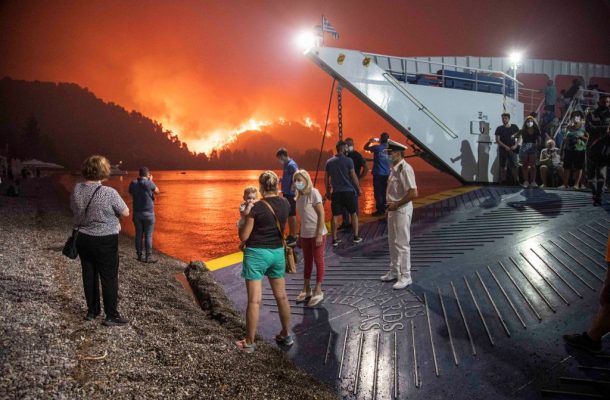The fire this time

Media coverage of the latest report of the Intergovernmental Panel on Climate Change released on Monday has highlighted many deeply disturbing findings, including that climate change is already contributing to extreme weather events in every inhabited region on the planet and that it’s probably too late to avoid global warming of more than 1.5°C, the lower target set in the Paris climate agreement.
But another important finding has received relatively little media attention. The IPCC has determined that we’re now entering an era of compounding extreme climate events, particularly droughts and heatwaves, that will increasingly emerge concurrently at multiple locations across the globe. The simultaneous impacts, particularly in crop-producing areas, will have serious consequences for human security.
Established in 1988 by the United Nations Environment Programme and the World Meteorological Organization, the IPCC is tasked with providing policymakers with regular scientific assessments on climate change, including developments in scientific understanding, assessment of the risks, and adaptation and mitigation options. These IPCC reports, which are issued every five to seven years, are the science-based foundation for climate policymakers.
Our understanding of the science of climate change has improved significantly since the publication in 2013 of the previous IPCC assessment report. These improvements include better climate model simulations; advancements in methodologies to understand human influence on a wider range of climate impacts, including weather and climate extremes; and new datasets with better spatial representation of changes in surface temperature, including in the Arctic.
Political action has also coalesced over this same period with the signing in 2015 of the Paris climate agreement, in which UN member states made commitments to reduce emissions in order to prevent dangerous levels of warming. The evidence suggests that they’re not acting ambitiously enough to achieve that aim. The last five-year period has been the warmest on record, and this latest IPCC report confirms that global temperatures have already risen by more than 1°C above pre-industrial levels.
The report’s confirmation that climate change impacts are now globally ubiquitous comes as no surprise, given the scale and magnitude of recent disasters. This year’s record-setting temperatures and fires in Greece, Turkey and the United States are reminiscent of Australia’s Black Summer bushfires, in which a record 24 million hectares burned.
This past month, heavy rainfall triggered severe flooding throughout Western Europe, Bangladesh and Central China, killing hundreds and displacing thousands. These increasingly disruptive disasters are one reason UN Secretary General Antonio Guterres has described the new IPCC report as a ‘code red for humanity’.
The report warns that these extreme events will increasingly occur simultaneously and has particularly highlighted the global risk to agricultural production. Of course, as the frequency of these hazards increases, the likelihood of their striking simultaneously or in close succession will grow. But important global climate ‘teleconnections’ also make simultaneous impacts more likely.
Simultaneous hazards periodically occur as part of natural climate variation, such as weather patterns linked to phases of the El Niño–La Niña cycle. The scale of the impacts is already significant. For example, in the 1998 El Niño-induced drought, 7.5 million Indonesians faced acute food shortages. Scientists expect 1.5°C of warming to double the frequency of extreme El Niño events and the IPCC report has concluded that continued warming is likely to magnify the rainfall variability related to both El Niño and La Niña events.
Some scientists also suspect that climate change is altering the northern hemisphere jet stream, contributing to simultaneous extreme weather events on a global scale (such as heatwaves, droughts and fires in some regions, and floods in others). These disasters in the northern hemisphere may be linked to changes in the jet stream, as might the 2010–11 global food security crisis that contributed to the outbreak of violence and the fall of governments in the Arab Spring.
The prospect of rapidly increasing, simultaneous extreme events affecting both global and local food security is deeply worrying. It will have major consequences for regional stability that will directly affect Australia’s national interests.
The scale of this risk underscores the urgency of more ambitious global action to reduce greenhouse-gas emissions. In this respect, it’s encouraging that a number of nations have significantly increased their climate commitments in the lead-up to November’s crucial COP26 climate conference in Glasgow.
But, as the IPCC report suggests, existing inertia in the climate system has already committed us to more extreme events with ‘increased intensities, durations and/or spatial extents unprecedented in the observational record’. Australia will clearly need to scale-up its own adaptation efforts and should make it a high priority to help its near neighbours do the same.
The IPCC report is both a sobering reminder of the scale of the challenge we face and an affirmation that the worst of the climate impacts can be avoided with rapid and more ambitious global action to reduce greenhouse gases and prepare for climate impacts.
This article was written by Robert Glasser and Matthew Page and published by The Strategist.
Robert Glasser is a Visiting Fellow at the Australian Strategic Policy Institute and is the former UN Special Representative of the Secretary General for Disaster Risk Reduction.














